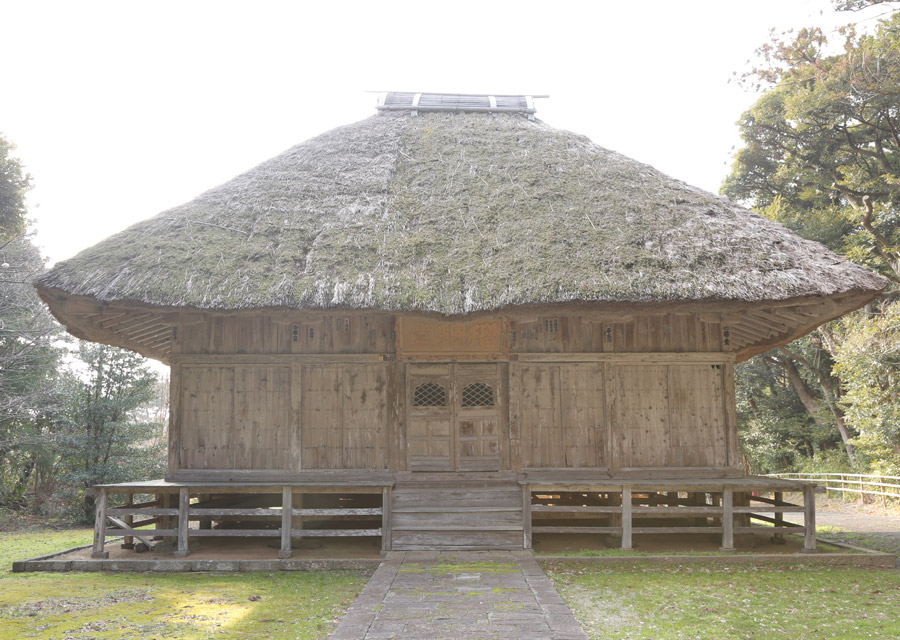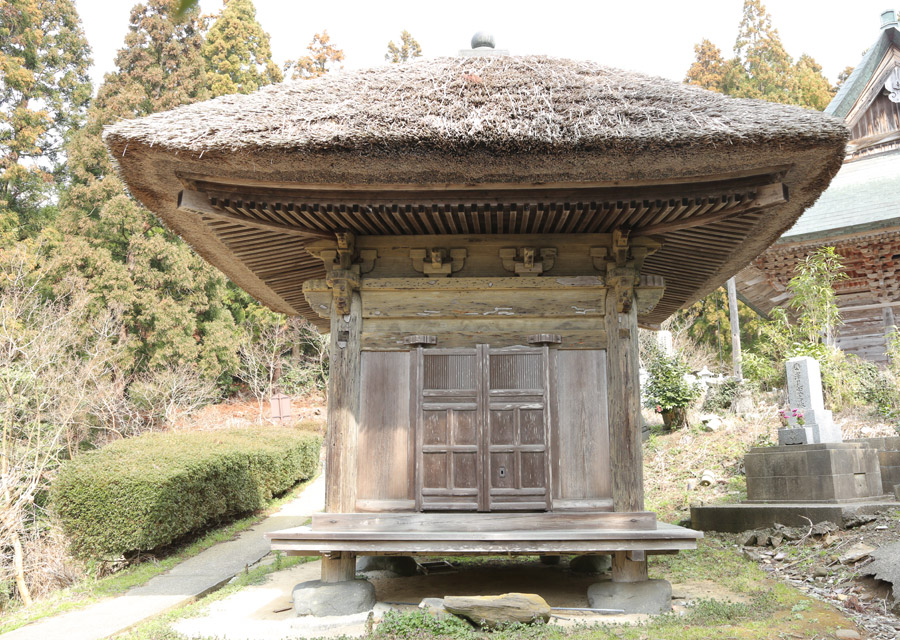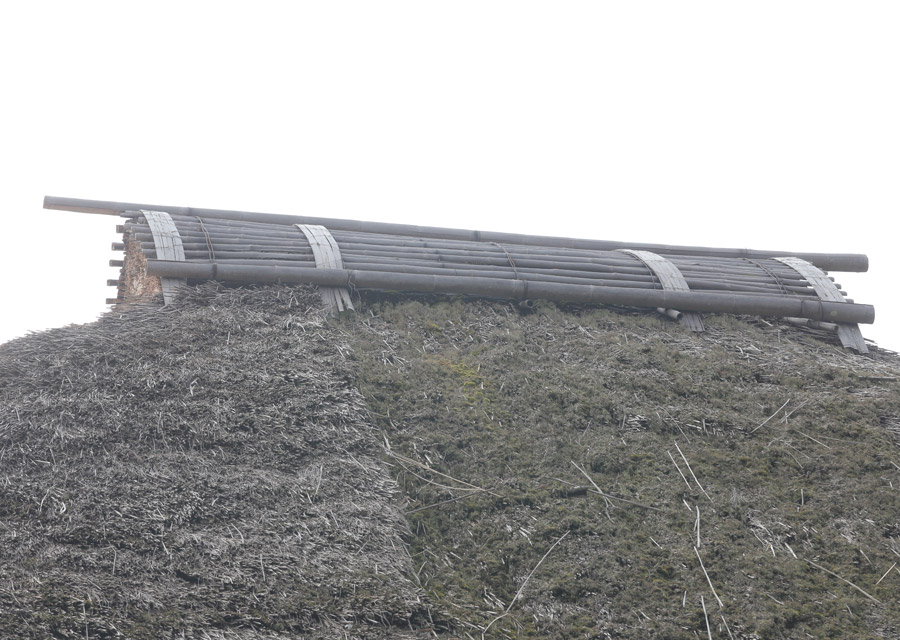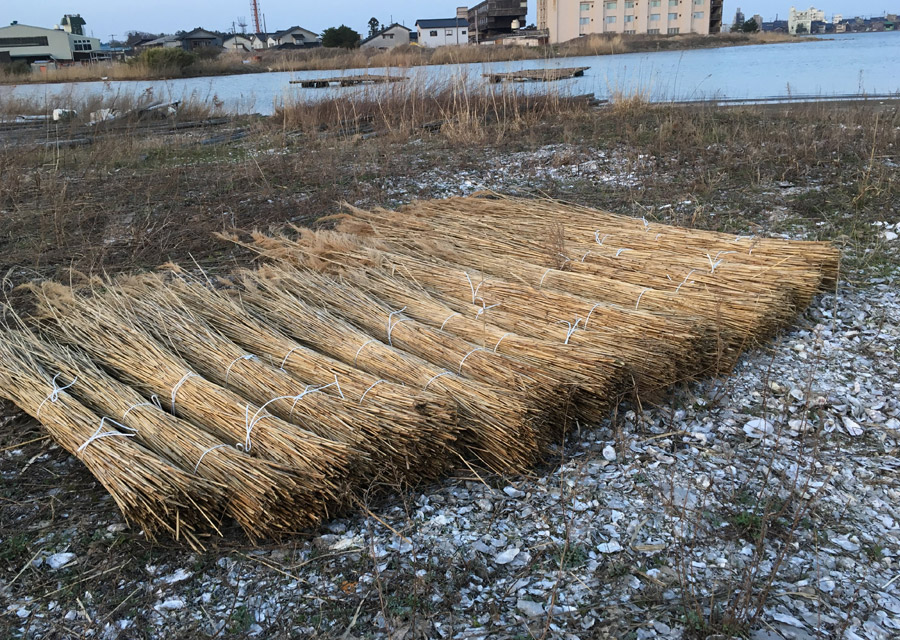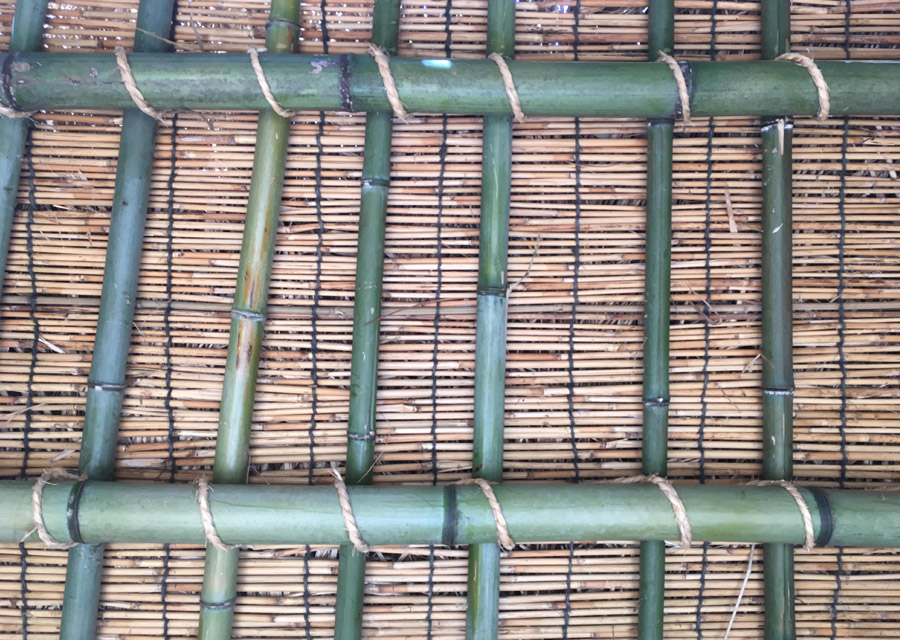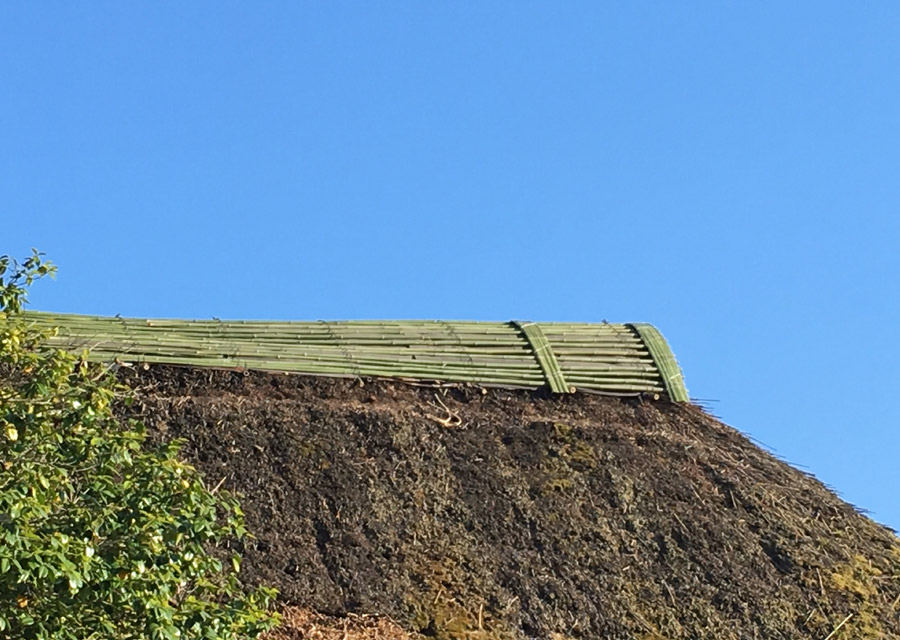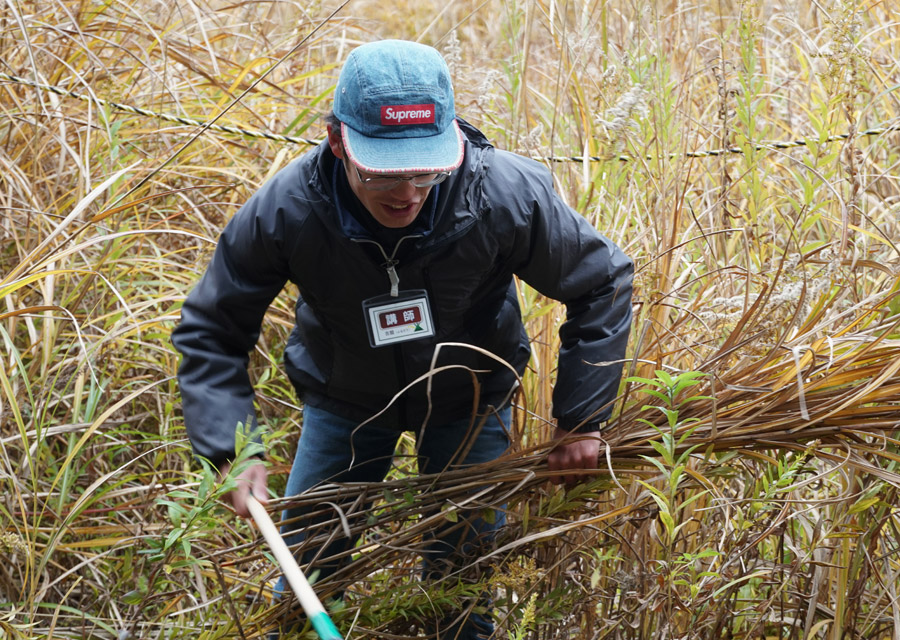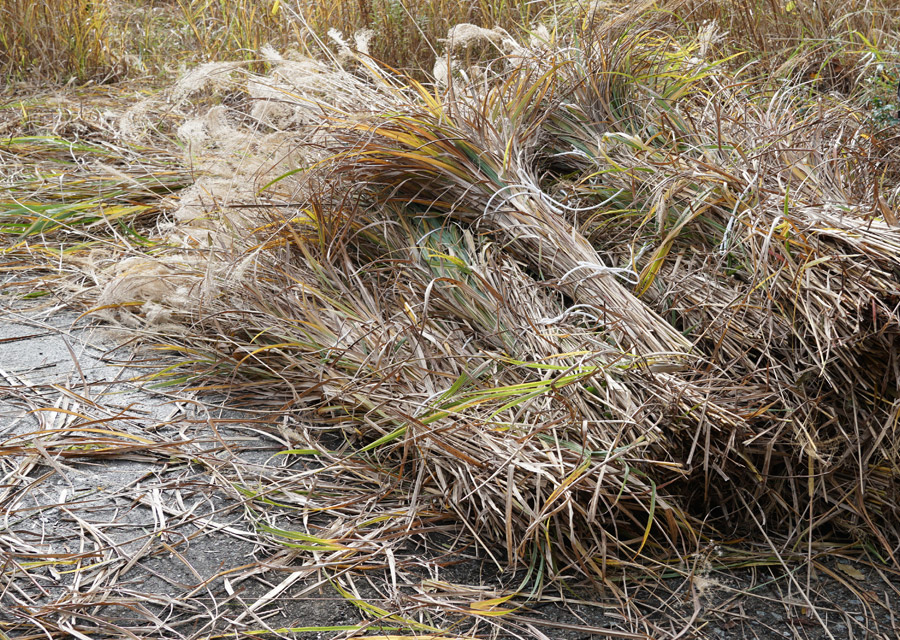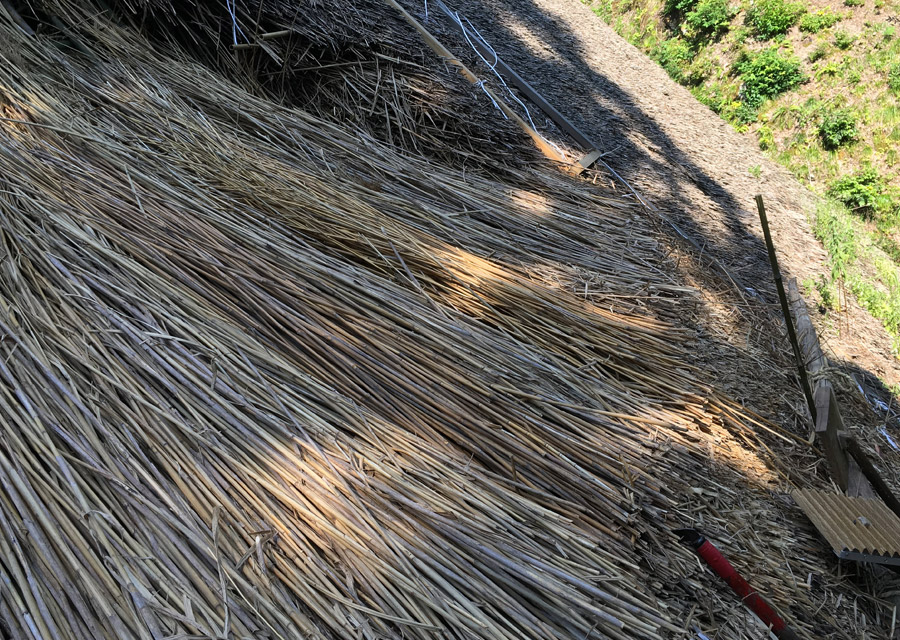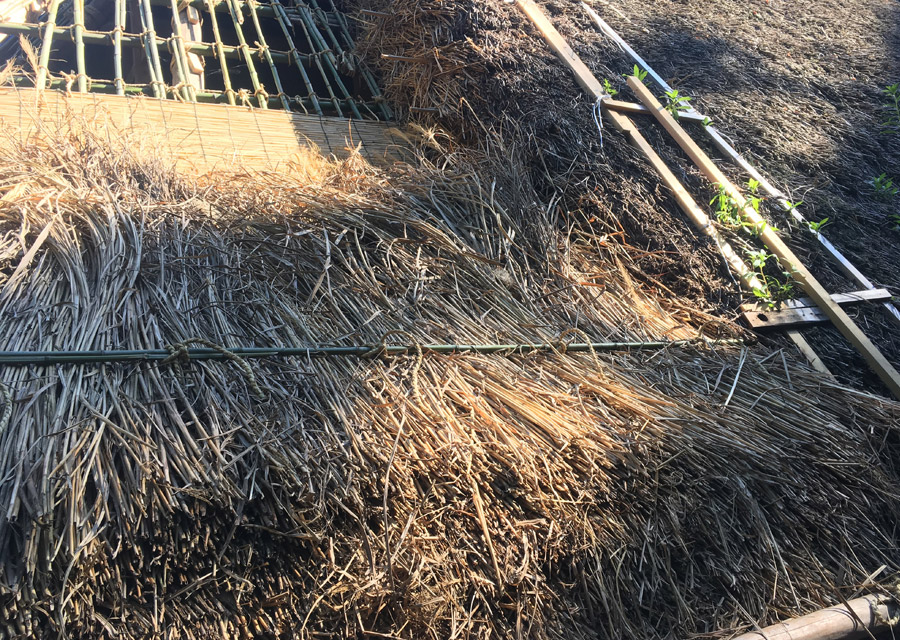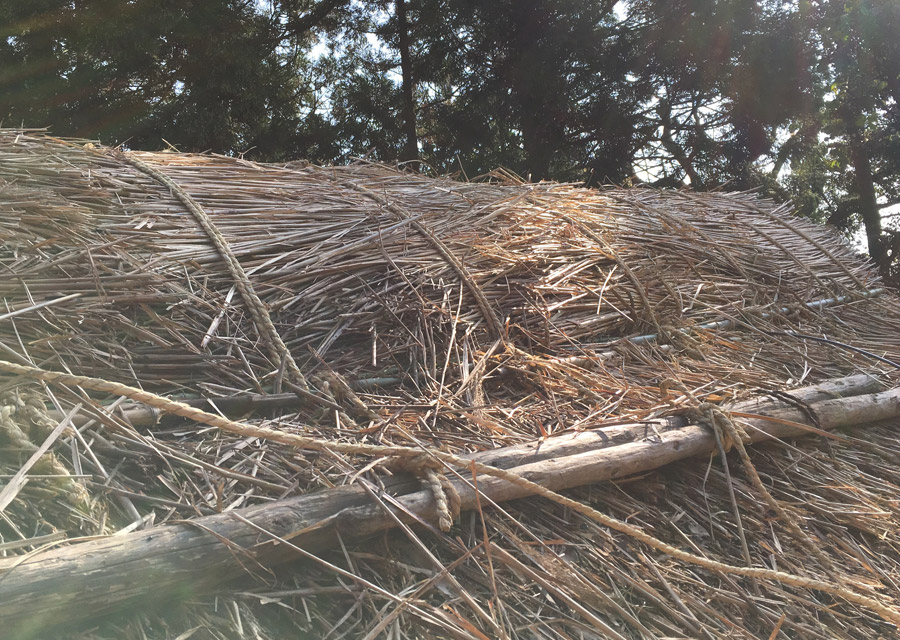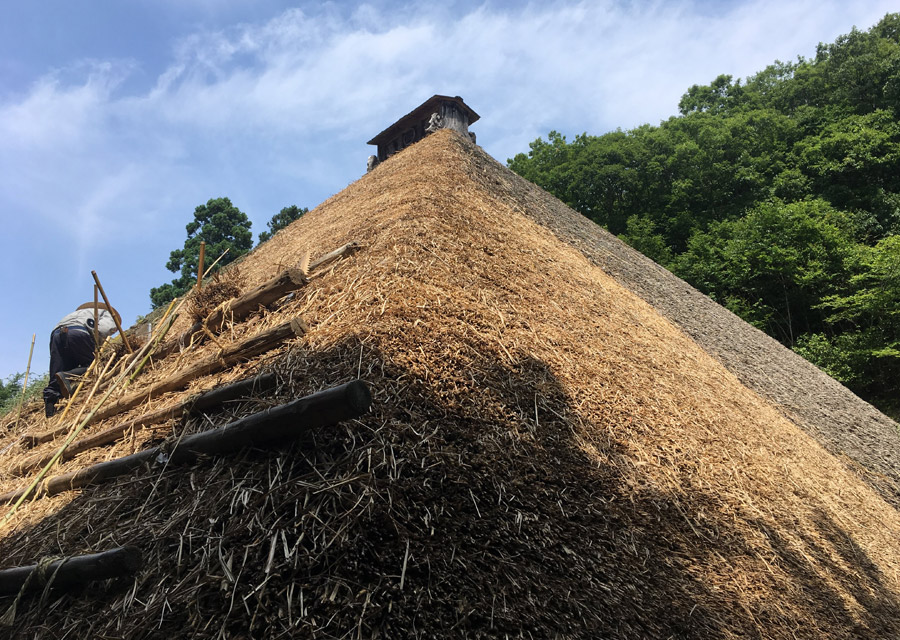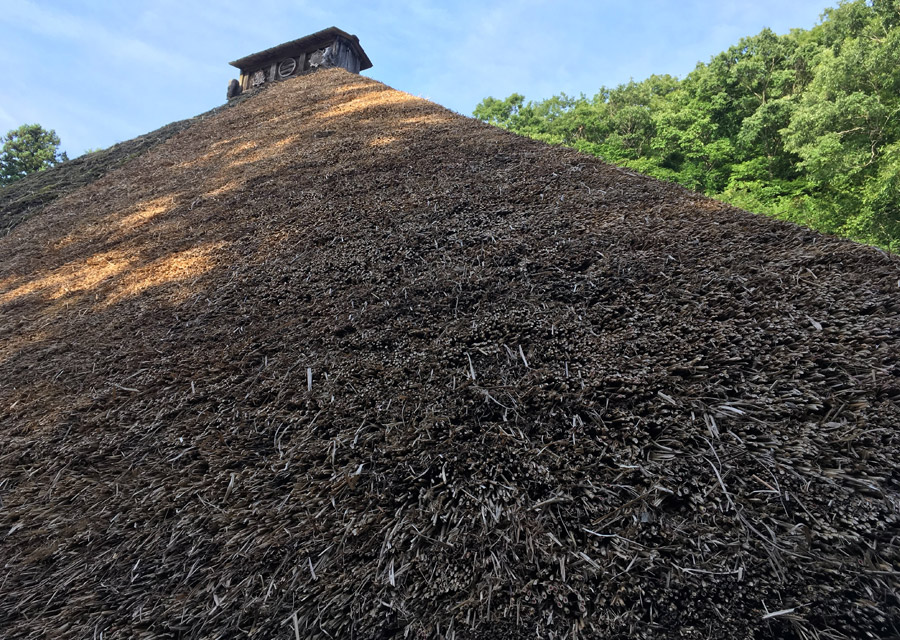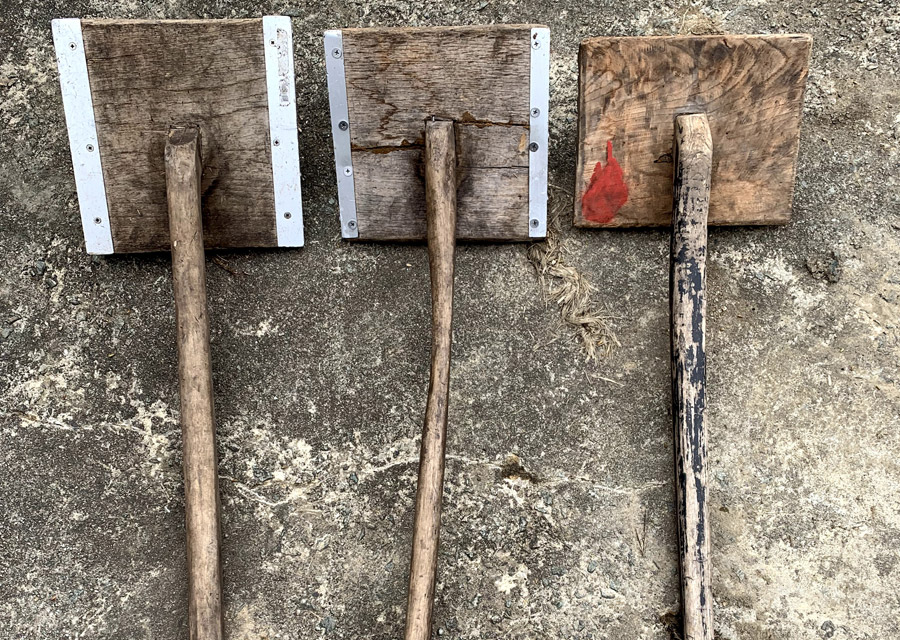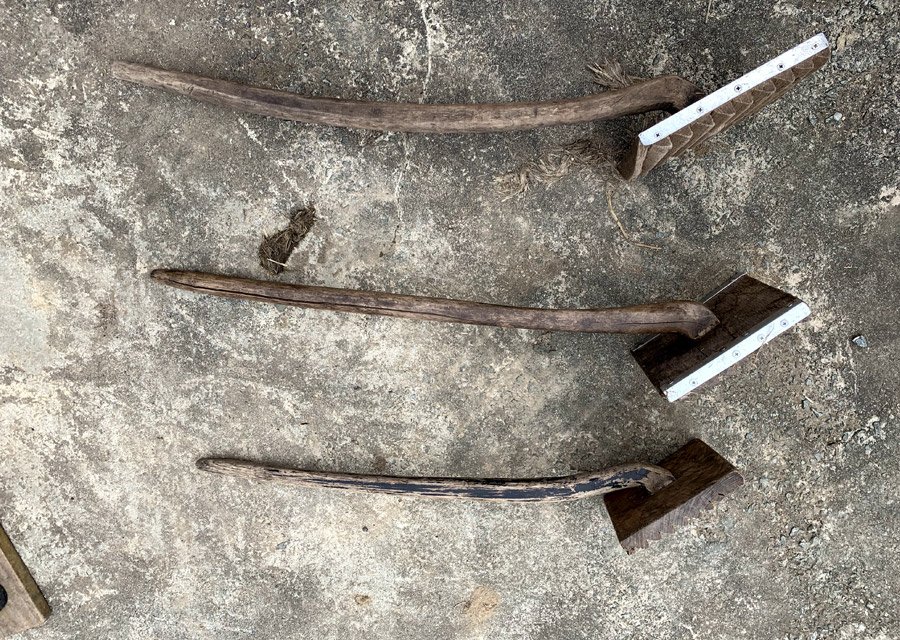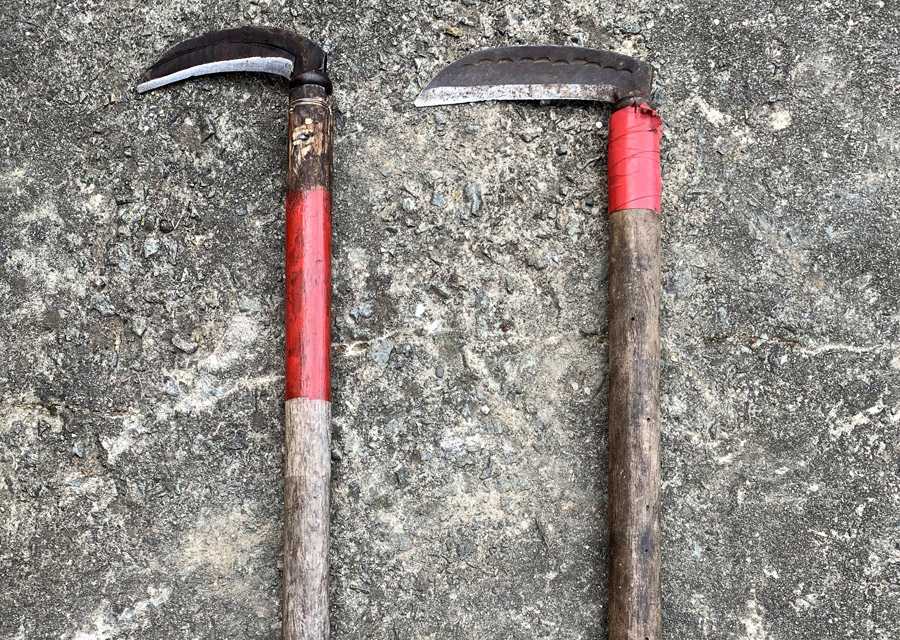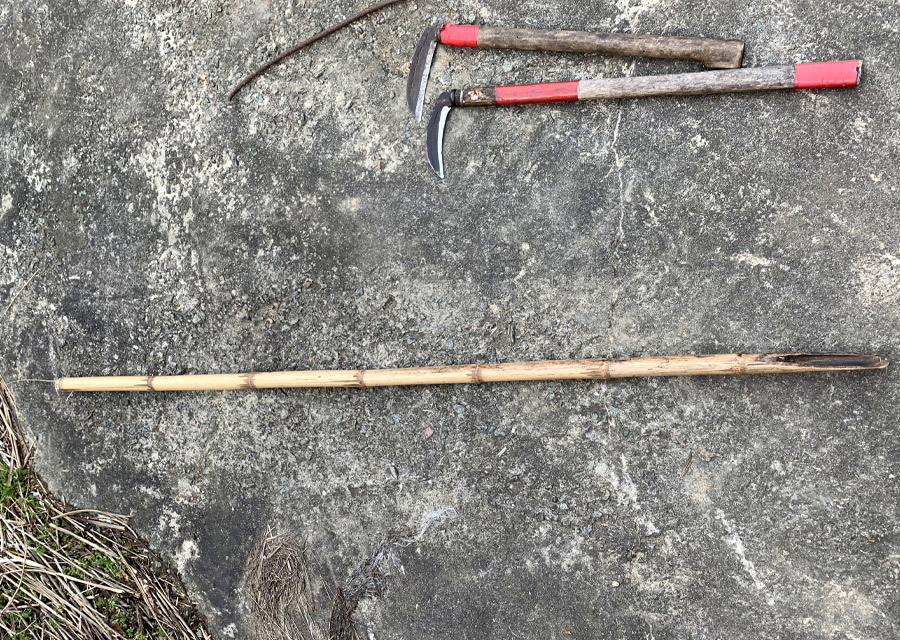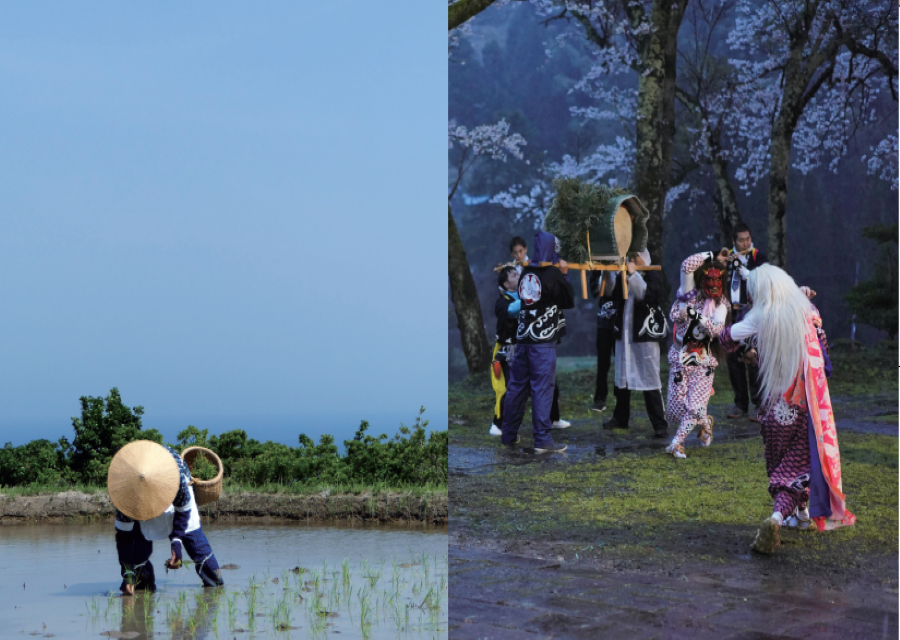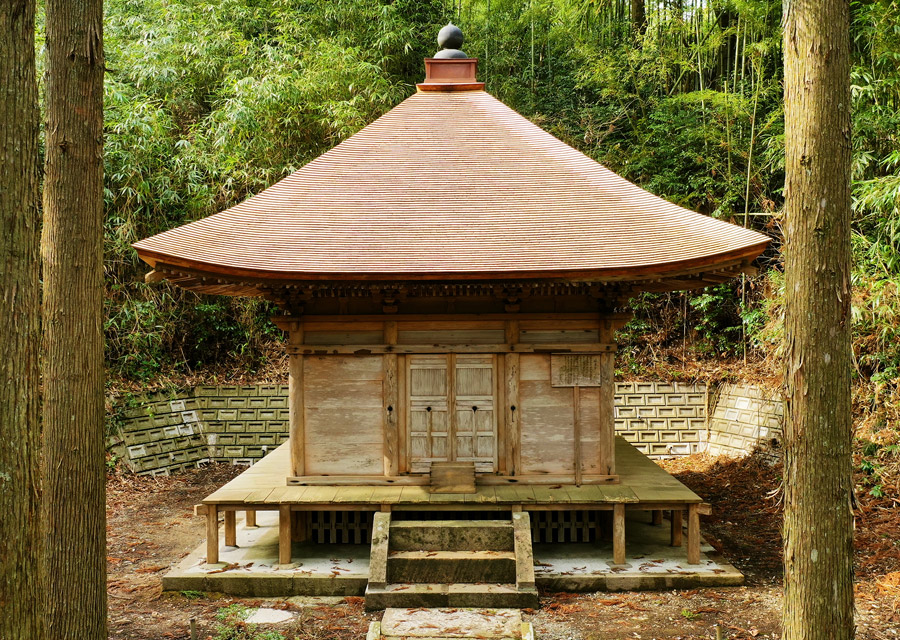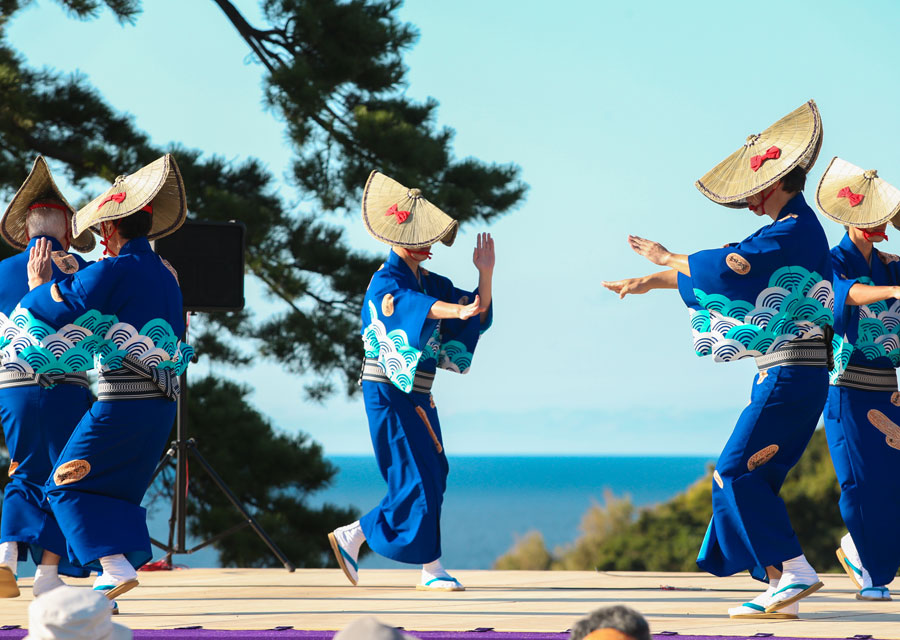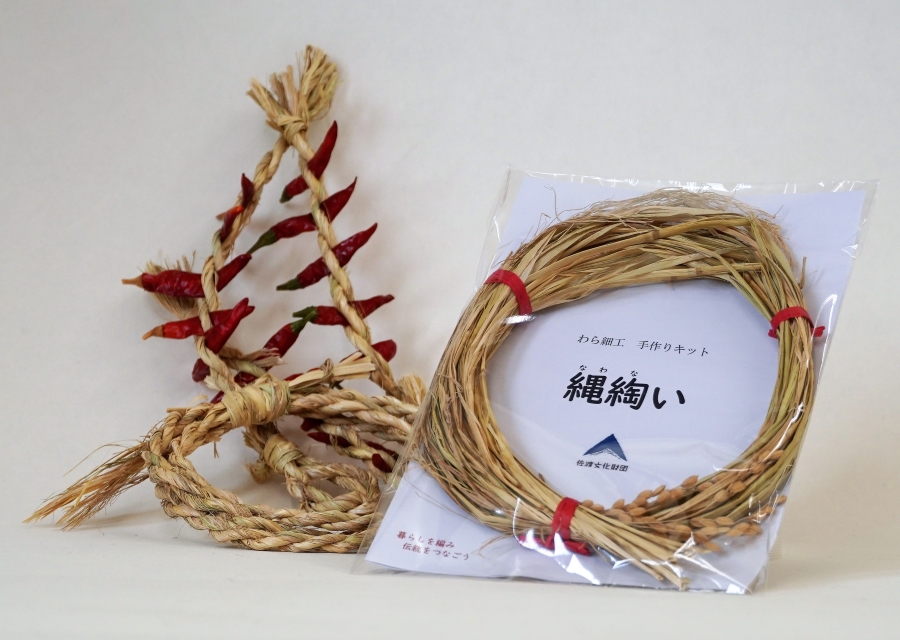What We Do
Thatch on Sado Island
Thatch on Sado Island
On Sado Island thatched roofs are called “kuzuya” or “kuzuyane”. Exact etymologies of these terms are unknown. Some say that they can be understood to mean “shabby roof”.
On Sado Island the flat front section, the flat rear section and the gables of a roof are called respectively “maenokō”, “ushironokō”, and “ōginoma”. The slope of the roof in Japanese is called nagare, but on Sado it is “nobori”. The Japanese term for “minoko (thatch edge at the gable end)” is “ogami”, and four corners of the roof are called “sumi” in Japanese but “suma” on Sado. The eaves elsewhere in Japan are referred to as “noki” but are known as “haguchi” on the island.
Characteristic of thatched roofs of Sado Island is the ridge. It is generally classified as a kōgai-mune (skewered ridge) and it is unusual for Niigata Prefecture. The most famous kōgai-mune are the thatched roofs of Shirakawa-go, a World Heritage Site on mainland Japan. However, in spite of this similarity in the finishing of roof ridges of Sado and Shirakawa-go, they are so different in appearance that their similarity is not widely appreciated. The finishing methods of the ridge on Sado Island and Shirakawa-go are essentially the same.
One of the technical characteristics of thatching in Sado is “haritori (lashing)”. This is usually performed by two people, one working from the outside of the roof and the other from within. Some Sado thatchers however do this process alone using unique tools. It is said that this technique originally developed in Teradomari – just across the water on the mainland – and spread to many regions including Sado Island. Now very few thatchers practice this technique in other areas of Japan making the knowledge of Sado’s thatchers irreplaceable.
Material
Roofs are thatched combining a variety of plant materials such as kaya (miscanthus), yoshi (reed), ashi (also a variety of miscanthus), ina-wara (rice straw), mugi-wara (wheat straw), ogara (hemp stalks) and choma (ramie).
Most thatched roofs are thatched with kaya, i.e. susuki (miscanthus).
Yoshi and ogi are are referred to as yoshi and ashi in Sado, respectively. Generally in Japan ashi is a synonym of yoshi, but in Sado Island ogi is called ashi. Reed is rarely used as the main thatching material however. It is said that a 50/50 mixture of kaya and yoshi lasts twice as long as 100% kaya. A homonym of ashi means bad. As the name suggests there are many low quality reeds that thatchers prefer not to use.
Rice straw, wheat straw, hemp stalks, and ramie are mainly used for the kotsura, the bottom layer of thatch of the eave. These 4 materials seem to have been used interchangeably, whatever was available at the time being used. Rice straw is often used today. Wheat straw seems to have been used when wheat was more widely grown. Wheat straw is still often found in existing thatched roofs and recycled. However, new wheat straw is no longer used. Ogara (the peeled stalk of hemp) seems to have been used in the era when hemp fibre was harvested. Hemp stalks are seldom found in existing roofs. When they are, they can be reused, but thatchers no longer use new ones. Choma (ramie), is also called karamushi. It also was a byproduct of fibre production. Apparently it was once used as thatching material but we have found no physical evidence yet.
Bamboo is used for the shitaji (frame), oshihoko (sway) and mune (ridge). In most cases frames are built with madake (Japanese timber bamboo) and sometimes hachiku (henon bamboo).
In Sado Island the sway is called osae-buchi. Curved sways at corners are called mage-buchi. Timber or henon bamboo are used as sways. Thin poles of timber or henon, or sometimes a bamboo called meguro-dake are used for the corners.
The ridge is also constructed with timber or henon bamboo. Mōsō bamboo is very occasionally used for aesthetic reasons.
Harvest
It is said that in Sado Island there used to be two thatching material harvesting seasons, aki-gari (autumn harvest) and haru-gari (spring harvest). The autumn harvest season lasts from November to the beginning of the snow season. Spring season is from the beginning of the thaw till the end of March. There are many ways of defining the start and end of a season. Some examples are “Start harvesting in November when the leaves are still green”, “After the first frost and leaves are fallen”, or “After New Year’s Day”. Naturally the climate varies from one area to another so the harvesting seasons were adjusted according to local conditions. Material harvested in the autumn and spring are called aki-gaya (autumn kaya) and haru-gaya (spring kaya), respectively. The condition of the leaves from autumn and spring kaya is different and so are used accordingly.
A unit of thatching material is called hiki. One hiki is a large bundle tied together with a 12 shaku (3.6 m) length of rope. A bundle tied with a 9 shaku (2.7 m) length of rope is called han-hiki (half hiki). A taba is a smaller unit and its diameter is about 25 to 30 cm. One hiki is approximately 15 taba. A regular-sized house on the island is 6 ken wide and 4 ken deep (10.8 m x 7.2 m) and it is said that it requires 40 hiki to thatch.
Thatching and re-thatching
To begin thatchers put up scaffolding. In Sado roof scaffolding is called dōchu.
Next is the removal of the old kaya. First, the ridge is dismantled. Old kaya is stripped off and bundled together with a binding material called tsuge made from rice straw. Usually all kaya above the kotsura is removed.
Then thatching begins. Old and new kaya are placed alternately. Old kaya are cut to the appropriate length. New ones are used as they are, without cutting. Sways are placed about 2 shaku (60 cm) apart and hold down the kaya. The knots that tie down sways are called kamemukuri or kamenoko-musubi.
Kaya are laid horizontally on the ridge to make a foundation. The majority of existing thatched roofs have a rounded ridge. It is said that there used be some roofs with triangular ridges. The foundation is covered with a waterproof material like cedar bark or tin and then covered with bamboo slats called mizara. The technique of making these bamboo slats – from the making of the bamboo strips to the number of strips required – varies from place to place. Currently bamboo slats are woven using 20 strips of halved bamboo. However, unsplit bamboo or quartered bamboo can also be used. The number of strips required varies from 7, 9, 13 (uneven numbers), to 40. Bamboo poles called gushi are thrust beneath the ridge and the ridge is then bundled with wires tied to the gushi.
In addition to bamboo slats, ridges are sometimes ornately decorated with bando (bands) or keshō-dake (ornamental bamboo).
When the ridge is done the kaya is cut from top to bottom with shears to complete the thatching. It is said that in Sado Island the trimming of kaya with shears was rarely done and that thatchers simply brushed off excess material from top to bottom by hand.
Tools
There are five tools principally used by thatchers on Sado. Hasami (shears), kote (legget), kama (sickle), hari (needle), and other tools made of bamboo.
Shears are used to trim the kaya. There are several kinds, such as haguchi-basami (eave end shears), ara-basami (rough cut shears), naka-basami (medium shears), and shiage-basami (finishing shears) each used for particular processes and sections of the roof.
The legget is called a kote or teita. It is used for pounding the top surface of the thatched roof evenly. The shape of the handle of the leggets of Sado is unique and similar to the ones used by Wakasa-style thatchers (Wakasa used to be a province around Fukui Prefecture, located north of Kyoto).
A characteristic unique to Sado’s sickles is their long handles. They are about 2 shaku (60 cm) long. The blade length is about 5 sun (15 cm).
Needles are used for haritori (lashing). There are two sewing techniques and therefore two kinds of needles. One of the needles is just like a regular sewing machine needle. Originally made of bamboo, some modern ones are made of metal. Each thatcher devises their own unique bamboo needles so many varieties exist. The other kind of needles are called kane-bari, made of metal, and these originated in Teradomari. Kane-bari are of a unique shape, being slightly curved steel rods with a hook on one end. The kane-bari is paired with a tool called haribō that pushes rope through the thatch into the attic. A thatcher can singlehandedly maneuver kanebari and haribō in order to sew the thatch.
There are tools made of bamboo such as the okoshi-bō and gushi. An okoshi-bō is used in the process known as sashi-gaya (a method of thatch repair). The gushi can be temporarily stuck vertically into the thatch to prevent material from falling off the roof and to work as footholds as well.
- Sado Cultural Foundation Home
- What We Do
- Thatch on Sado Island

